Gayle Irwin's Blog, page 4
December 23, 2020
Keep Your Pets Safe This Christmas
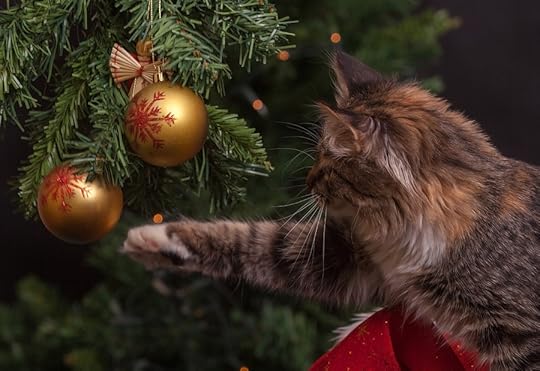
How safe is your home this holiday season? As we hurry and scurry, our pets can be neglected and their safety overlooked. Even though this December may be different from others in how we shop and spend our days, don’t let the season bring disaster to our pets.
Here are some tips to help keep the furry companions in your household safe this Christmas:
Be mindful of Christmas trees and decorations. These are lovely to look at, but they can cause issues for our pets. Christmas trees may be knocked over by cats climbing into them or by pets attracted to the decorations hanging on them. Garland and tinsel, for example, may be ingested, choking, or even killing cats and dogs. Candles can be knocked over by either people or pets, and thereby, cause a fire. When using decorations, choose those that pose less danger to your household.Is the water safe? Make sure your pet always has fresh water in its dish so it’s not tempted to drink from the water at the base of your live Christmas tree. Place a tree skirt around the tree to cover the water in the base. Christmas tree water becomes dirty and stagnant, and pets that drink it can ingest not the bacteria as well as pine needles that drop, causing potential harm to your dog or cat.Beware of hazardous plants. Some flowers and other plants that people enjoy at Christmas pose health hazards for dogs or cats or both. These include mistletoe and poinsettia. Keep them out of reach or consider purchasing artificial ones. Learn which plants can cause harm to your dog or cat at this ASPCA website: https://www.aspca.org/pet-care/animal-poison-control/toxic-and-non-toxic-plantsWatch that escape hatch! As people come and go from your home, your dog or cat can more easily run out the door. You may want to put your pet in an extra bedroom or the laundry room if you expect your door to be opening and closing a lot on a particular day, such as holiday shopping or your family’s Christmas Day celebration. This is also a good time to ensure your dog and cat’s ID tags and microchips are up-to-date in case of an escape.Turn down the stress. This year has caused more stress for a great number of people. The holiday season, although meant to be joyful and relaxing, often adds to people’s stress level. Our pets pick up on that. They, too, can become more agitated and disturbed (see the article above on behavior). For your better health as well as the mental and physical health of your pets, try to lower your stress level. Whether soothing music permeates your home, you do yoga and deep breathing, or you simply relax on the couch with your furry friend and read, these practices and activities can help turn down the stress-o-meter in yourself and your household.Watch what they eat. Food is an integral part of the Christmas season, and there are many items people eat which are health hazards for our pets. These include poultry bones, gravy, and chocolate. Keep your pets’ food routine the same during the holidays as during ‘regular days’– you’ll avoid upset stomachs or worse.
Following these guidelines will help you and your furry friends to enjoy the holiday season more fully!
Find additional Christmas safety tips here: https://www.aspca.org/pet-care/general-pet-care/holiday-safety-tips

December 14, 2020
Book Review: “A Golden Christmas” by Eliza Boyd
 Golden retrievers are among the most popular dog breeds in the United States, not only as family pets, but they also as service and therapy dogs. Pixababy photo.
Golden retrievers are among the most popular dog breeds in the United States, not only as family pets, but they also as service and therapy dogs. Pixababy photo.I began reading books written by Eliza Boyd within the past few years. I discovered her Christmas novelette, A Golden Christmas, earlier this year. The family-themed story is heartwarming and may even make you shed a tear or two by the end.
Family and Christmas go together like hot chocolate and marshmallows. This is a book with which you should sip hot chocolate or cider while sitting near the warmth of a fireplace. It’s the story of a family who has experienced a loss, but whose love for one another is strong. They take in a lost golden retriever, who shows up at their home during a snowstorm. The young kids are quite taken with the affectionate dog, and soon the parents are drawn to the sweet dog as well. However, they do the right thing and attempt to find the family to which the dog belongs. As days pass, the retriever, christened “Golden” by the caring family, settles into the household as if he had always belonged there. By the end of the story, readers will find out why.
Family and Christmas. Christmas and a Dog. Family, Christmas, Dog, Delightful Story = WINNER! If you’re looking for a special short read this season, pick up A Golden Christmas by Eliza Boyd! Here’s the link to her book on Amazon: https://www.amazon.com/gp/product/B0784DHZ3T/ref=dbs_a_def_rwt_hsch_vapi_tkin_p1_i9
As an author of romance stories that weave in pet rescue and adoption, I’m always excited to discover similar reads. When I learned about Eliza Boyd and her book A New Leash on Love last year, I bought it immediately. I also purchased her follow-up book No Kidding in Love, and I look forward to her next installment in this True Love Animal Sanctuary series! Therefore, when I learned of this short story she’d written for Christmas, A Golden Christmas, I added to my Kindle immediately. For people like me who enjoy reading sweet romance stories that weave animals into the pages, Eliza Boyd’s works need to be added to your reading list. A Golden Christmas is just .99 cents on Kindle.
She composes other romance books as well, so if animals aren’t quite your thing, check out her other various series here: https://www.amazon.com/Eliza-Boyd/e/B00XM6OBFE/ref=dp_byline_cont_pop_ebooks_1
Meet Some Other Authors
As you prepare for the last few weeks of Christmas, remember that books make great gifts! I recently read excerpts from my own Pet Rescue Romance series in a Facebook Live presentation – you can view that on my Author Facebook page here: https://www.facebook.com/GayleMIrwin
All three of the books in the series thus far are available on Kindle and Barnes & Noble for just .99 cents. They are also available as print books. Plus, you can get my short story Gram’s Legacy, a prequel for the series, for FREE on those e-book platforms as well.
Recently I gathered with three other authors via Zoom for an event called “Romance Through the Ages.” You can view that talk and learn about authors Neva Bodin, Casey Peeler, and Jessie Andersen on my YouTube channel here: https://youtu.be/tjDr5-_zG18.
In a similar vein, six other Wyoming female authors and I Zoomed on an event called “Central Wyoming Women Authors Holiday Extravaganza.” All eight of us live either in Casper or Cheyenne, Wyoming. The event features children’s and YA authors, romance novelists, Christian devotion writers, and authors of memoir. You can view that special author gathering on my YouTube channel as well by clicking here: https://youtu.be/kuVLvpdHgiE
Reading is a delightful pastime, and it can be fun to discover new writers. Reading is a great way to enjoy the upcoming months of cold and snow, for you and/or someone you love!
How many more shopping days until Christmas??!!

December 9, 2020
Naming Pets, Naming Characters
 Dogs and cats provide love, laughter, and activity. Naming our beloved furry friends can be challenging yet fun. Photo by Tamas Pap on Unsplash
Dogs and cats provide love, laughter, and activity. Naming our beloved furry friends can be challenging yet fun. Photo by Tamas Pap on UnsplashNaming our pets is like naming a baby – sometimes the process is excruciating, and sometimes it’s easy. Whether you get a kitten or puppy or if you adopt an adult animal, naming (and having your furry friend respond to that name) is important.
When people adopt a dog or cat, sometimes they keep the moniker given and at other times the pet’s name is changed. For example, the shih tzu my husband and I adopted from Hearts United for Animals three years ago had been christened ‘Stormy.’ Before we even met him, we knew we wanted to change it – that name, for us anyway, just didn’t seem to fit. So, we named him ‘Jeremiah.’
 My shih tzu, Jeremiah, was named ‘Stormy’ by the rescue organization from which we adopted him. He learned his new name quickly.
My shih tzu, Jeremiah, was named ‘Stormy’ by the rescue organization from which we adopted him. He learned his new name quickly.Why that name? I don’t know exactly, except for this: it’s the only one we agreed on! For us, re-naming this rescue dog didn’t come easily – we tossed ideas around, including names of St. Louis Cardinals baseball players, like ‘Yadie,’ (nickname for the team’s famous catcher), but none appealed to both of us. Then, we started with Old Testament Biblical names, and ‘Jeremiah’ clicked … for both of us! The little guy, who was five years old when we adopted him, learned his new name fairly quickly.
Last year, we adopted a springer spaniel named Sadie. We didn’t change her name. She was already eight years old, and we both liked the name, so we kept it.
We adopted the two cats living in our home when they were 10-week-old kittens (they are more than 15 years old now). Coming up with names for them seemed to be an easy process. My husband’s ancestors are Irish, and we both like Irish drinks, so Murphy (stout beer) and Bailey (Irish cream) seemed appropriate.
 Murphy and her sister Bailey were fun to name, and their names came easily — in honor of my husband’s ancestry and the Irish drinks we enjoy!
Murphy and her sister Bailey were fun to name, and their names came easily — in honor of my husband’s ancestry and the Irish drinks we enjoy!A person can find meanings of names on the internet as well, for example at and . These can be helpful resources if you’re naming a baby, a pet, or story character. (I learned ‘Jeremiah’ meant “exalted by God,” which seemed appropriate since our beloved shih tzu came out of a horrible puppy mill situation).
As a fiction author, I must come up with names for characters. I find that a somewhat difficult process. For some reason, my female character names come more easily (perhaps because I’m a woman??) than names for my male characters. While writing Rescue Road, my first pet rescue romance novel, I needed a villain; my husband suggested ‘Dylan the Villain.” I nixed that. However, I’m considering the name ‘Dylan’ for one of my 2021 releases because it seems an appropriate name for the setting and story.
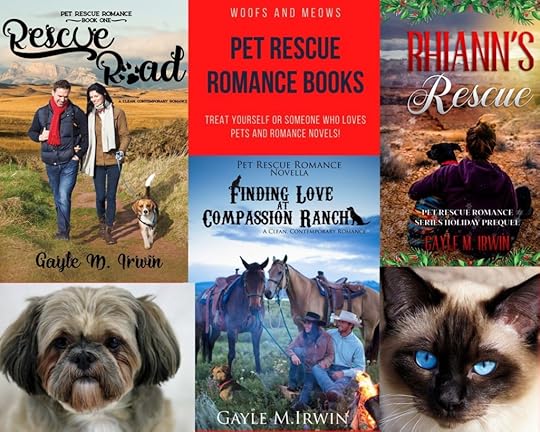 Naming characters in my books, including the animals, is a process that includes research … but it can fun!
Naming characters in my books, including the animals, is a process that includes research … but it can fun!A fun way for me to research names, especially for book characters, is via the internet. I’ve discovered several websites that provide potential character names. The same is true for baby names and for names for pets. Recently, came out with a list of popular dog names for 2020, including ones named after food items! (That list includes Croissant – a friend of mine christened her cat with that moniker!).
‘Sadie’ is on that list, so our springer has a popular name. However, Jeremiah didn’t make the list, however, one of the dogs in my book Rescue Road, whose name is ‘Jax’’ is on the list. My Jeremiah is the role model for ‘Jax.’
Daily Paws also provides a list of , which includes book-inspired names like ‘Jo’ from Little Women and ‘Edward’ from Twilight. You can also choose from celebrity names, like ‘Kanye’ (West) or junk food, like ‘Soda Pop.’
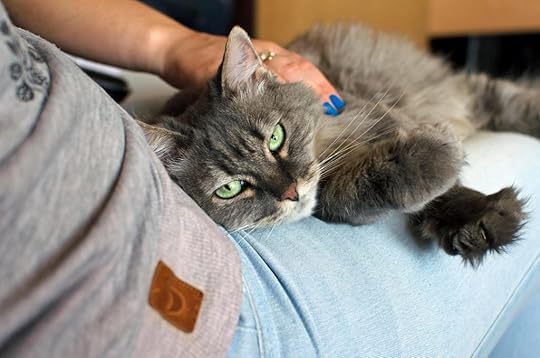 Naming our pets can be a fun experience … and a lengthy process. Just like with human babies, we want our pets’ names to be meaningful in some way. Pixabay photo.
Naming our pets can be a fun experience … and a lengthy process. Just like with human babies, we want our pets’ names to be meaningful in some way. Pixabay photo.If you’re a fiction writer or want to be, provides some helpful tips on naming characters, and the famously helpful author platform, , even has a name generator. Both could also be helpful in naming pets, as could be the other resources I mentioned earlier.
How do you choose a name for your pet? Have you ever changed an adopted animal’s name?
November 24, 2020
Thanksgiving Safety Tips for Pet Parents
 Pets are drawn to people food, especially during the holiday season. However, it’s best they enjoy their own food and treats, not scraps or tempting human food items from the table or kitchen.
Pets are drawn to people food, especially during the holiday season. However, it’s best they enjoy their own food and treats, not scraps or tempting human food items from the table or kitchen.With America’s Thanksgiving approaching, many organizations and pet advocate groups issued safety tips for pet owners. Human foods such as raisins, onions, garlic and turkey skin can cause health issues in our pets, therefore, feed your pets their usual foods and let the humans at your table eat the human meals.
FreshePet, one of the leading brands of dog food (found in rolls in refridgerators in pet supply stores, grocery stores, and big box stores), recently produced a blog post with a safety guide for Thanksgiving. I have used this dog food in the past, especially for my older dogs and those who could no longer tolerate kibble. The company also creates cat food.
FreshPet has not experienced a recall during the past several years, and, according to DogFoodAdvisor.com, is considered an above-average dog food.
Read the FreshPet blog about Thanksgiving safety for dogs and cats here: https://freshpet.com/blog/thanksgiving-pet-safety-tips/
Below is an infographic to remind you and your guests the do’s and don’ts for this holiday season.
If you celebrate American Thanksgiving, may you and your family, including your four-footed members, enjoy a safe, healthy, and happy holiday!
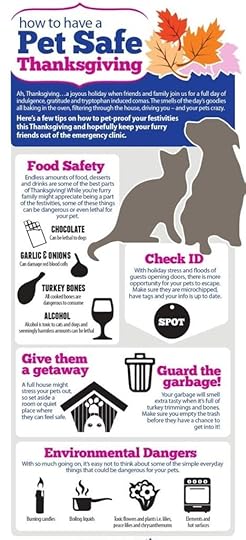
November 10, 2020
5 Positive Ways to Help Your Aging Pet
 Cody, the cocker spaniel who lived with us from age 10 to almost 18.
Cody, the cocker spaniel who lived with us from age 10 to almost 18.His name was Cody. We adopted the handsome cocker spaniel from the local humane society when he was 10. He lived to be almost 18 and during those years we shared walks, vacations, laughter, and cuddles. He was not the only senior pet I’ve had.
I adopted Ama, my long-haired, part Ragdoll cat, when she was two years old – she lived to nearly 19. The cats in our house today, Murphy and Bailey, came to us when they were 10 weeks old; they are now more than 15 years old. Currently, we also have two 9-year-old dogs. Senior pets have been part of my life for decades.
We can’t stop, or even, slow time, not for ourselves and not for our pets. Everyone ages, including our beloved animals.
 As much as we’d like to slow down time, we’re unable to do so. However, we can treat our older pets with lots of TLC and help them live long and happy lives. Unsplash photo.
As much as we’d like to slow down time, we’re unable to do so. However, we can treat our older pets with lots of TLC and help them live long and happy lives. Unsplash photo.Tips to Keep Your Older Pet Healthy and Happy
Many of us live with older pets, whether they are elderly when we adopt them or they have lived with us since kitten/puppyhood or since they were young adults. Our senior pets need extra-special care as their bodies and mental states grow older … just like people. Here are five positive ways we can help our aging animals:
Schedule vet visits every six months instead of every year. Even though vaccinations are required that often, having your dog or cat checked twice a year helps your vet notice any changes in health, such as lumps and bumps that could be cancerous, any change in your pets lungs or heart, or change in weight. Because obesity is on the rise in pets as it is among humans and overweight animals tend to develop other health issues, it’s a good idea to know if your elderly pet is gaining or losing weight and how that might affect his/her health.Feed your senior pet quality food. Feeding your aging dog or cat better food helps your pet stay healthier longer, providing the nutrition an older animal needs. The Dog Food Advisor created a list earlier this year of better quality dog foods for senior dogs, which includes Pro Plan Bright Mind by Purina and Wellness Core for Senior Dogs, among several others. Feline Living reviewed senior cat food and developed a list of good foods for older cats, which included Nutro Senior Indoor (dry), Now Fresh Senior Weight Management (dry), and Instinct Ultimate Protein Grain Free Pate (wet), among others.Engage your older pets in play and other activities. From walking around the neighborhood to playing fetch, our older pets still need exercise. Arthritis can impact how much, how often, and how active that exercise could and should be; however, just like people, older animals need activity for both physical and mental health. Cats should be encouraged to chase feathers, play with catnip mice, or run after rubber balls, and dogs should be walked regularly, spend time at the dog park, or chase a ball or other toy in the back yard. Activity is stimulating … and necessary. And the companionship you and your pet share during play benefits both of you.Cut back on the treats. Just as humans need to curb the sweet and chip snacking, out older pets also need to be limited on how many and what types of treats given. Many pet parents provide their dogs with vegetables, like broccoli and carrots, instead of biscuits and jerky. Talk with your veterinarian or research online about the types of snacks you should feed your older dog or cat.Be mindful of illnesses senior animals are prone to. As our animals age, their bodies can be impacted by various diseases, including diabetes, cancer, arthritis, and kidney failure, as well as other health issues such as blindness and deafness. There are ways to navigate such waters and many alternative therapies, like CBD oil, hydrotherapy, massage, and acupuncture, can help ease pain and provide a longer life for our beloved animals. Talking with your vet and with other pet owners helps ease the burden and guides us in decision-making.
 Keeping pets active, even in their older age, is good for their mental as well as their physical health. Engage them with toys and take them on walks to keep them active … and you as well! Unsplash photo.
Keeping pets active, even in their older age, is good for their mental as well as their physical health. Engage them with toys and take them on walks to keep them active … and you as well! Unsplash photo.You and Your Pet Can Age Gracefully Together
Just like people, pets are living longer, and their care is paramount in their older age just as it is when they are young. However, recognize older pets require a bit more TLC, and for all the joy, companionship, and devotion they give to us, that additional tender loving care is worth it!
For more information on caring for a senior pet, visit the ASPCA Pet Insurance site here: https://www.aspcapetinsurance.com/resources/how-to-care-for-senior-pets/
October 26, 2020
5 Tips for Keeping Pets Safe During Halloween
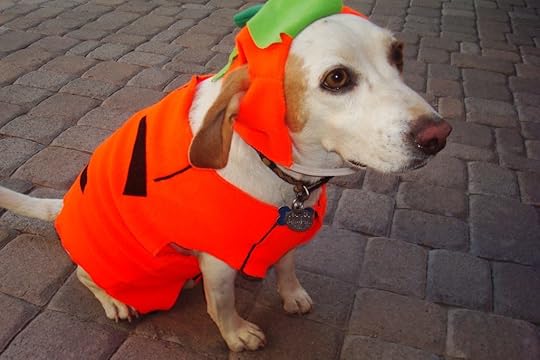 Pet parents often dress up their furry friends during Halloween. However, not all animals enjoy costumes,, therefore, prepare your pet ahead of time and make sure the clothing is safe for your pet to wear. Pixabay photo.
Pet parents often dress up their furry friends during Halloween. However, not all animals enjoy costumes,, therefore, prepare your pet ahead of time and make sure the clothing is safe for your pet to wear. Pixabay photo.Although the COVID crisis may impact Halloween parties and trick-or-treating events this year, there still may be enough activity and shenanigans to frighten, even harm, our pets.
Halloween brings out a lot of spookiness, including threats to black cats. Some statistics show an increase in animal cruelty during this time of year, and because black cats are surrounded by myth and superstition, companion animal groups caution pet owners to keep their cats (and dogs) securely indoors during Halloween.
If ghouls, goblins, witches, vampires, and other costumed creatures come knocking at your door, those get-ups can be scary to our pets. Strangers standing at the door covered in make-up and masks may frighten your animals, and constant doorbell ringing and the opening and closing of the door can upset our animals, even make them frantic. They may look for an escape and take advantage of an open door to run. Therefore, make sure your pet is in a secure place, such as a different room or in his/her crate, during trick-or-treat time.
 Black cats are often targets of pranks and animal cruelty during Halloween. However, any animal can be subjugated to such endeavors; therefore, keep pets safely indoors. Pixabay photo.
Black cats are often targets of pranks and animal cruelty during Halloween. However, any animal can be subjugated to such endeavors; therefore, keep pets safely indoors. Pixabay photo.As Halloween descends this week, you may want to curb and discourage the potential barrage of people at your door because of COVID, However, if you decide to operate “business as usual” and hand out candy or other treats, here are a few tips to keep your pets safe during Halloween:
Ensure Halloween decorations are not reachable by your pets. Candles, lights and wires, and other things can be dangerous, whether tipped over or chewed. Therefore, make sure your cat or dog cannot reach the decorations.If you dress up your pet, make sure the costume is safe. According to the ASPCA, “make sure the costume does not limit his or her movement, sight or ability to breathe, bark or meow. Check the costume carefully for small, dangling or easily chewed-off pieces that could present a choking hazard. Ill-fitting outfits can get twisted on external objects or your pet, leading to injury.” Don’t wait until Halloween night to put the costume on your pet – like anything new, if your dog or cat hasn’t worn a costume before, doing so will take some adjustment time.Keep candy and other treats away from pets. Many human foods are dangerous for dogs and cats to eat; therefore, stash your goodies stash! However, if you believe your animal snatched and ate some candy, or something else toxic, contact your veterinarian or the ASPCA Poison Control Center (888-426-4435) immediately.If your pet trick-or-treats with your family, make sure everyone wears reflective costumes or tape. Ensure everyone’s safety while walking sidewalks and streets by having reflective costumes or tape on those costumes. Drivers cannot see dark costumes and like joggers or walkers wear reflective gear while exercising in the dark, so should your children and animals wear such while out trick-or-treating.Ensure your pet has identification in case s/he escapes your house and gets lost. Having collar and ID tags and a microchip helps pets return home more quickly. Therefore, make sure your pet’s ID is updated before Halloween and that s/he is wearing a collar and ID tag and is microchipped in case s/he slips outside.
You can find additional tips here: https://americanhumane.org/blog/keeping-halloween-fun-and-not-scary-for-your-pets/?gclid=EAIaIQobChMI3e-Y9bjS7AIVYSCtBh0rhwBiEAAYASAAEgICe_D_BwE
AND here: https://www.humanesociety.org/resources/halloween-safety-tips-pets
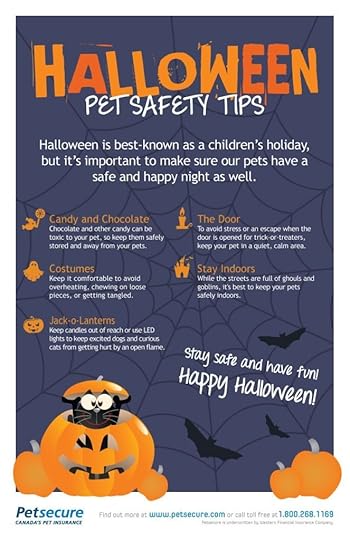
October 20, 2020
Pets are Powerful Therapy
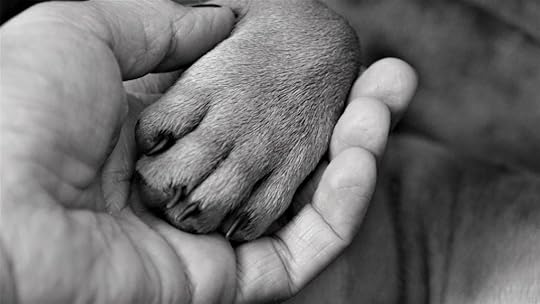
Every fall for the past several years, American Humane teams up with Hallmark Channel to present the Hero Dog Awards ®; the event took place last night. One of the categories is for therapy animals, who can bring joy and comfort in various stressful situations, at home, in hospitals, at schools, or in other places.
Benefits of Therapy Animals
Dogs and people share a unique bond, and that becomes even more apparent in a setting such as a hospital or a nursing home. People in these places often feel weak, are in pain, and get discouraged. Many are lonely. Therapy pets raise their spirits, bringing smiles and joy into situations that can be sad and scary. Various organizations certify pets and their owners for visiting these and other public places, such as libraries. and studies show these animals provide great benefits to those whom they visit, such as reducing anxiety, increasing confidence, and decreasing loneliness and depression.
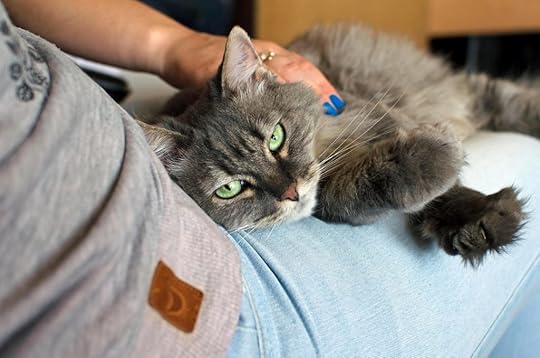 Dogs, cats, and other animals provide emotional support for people.
Dogs, cats, and other animals provide emotional support for people.Different types of animals can be used in therapy situations; cats, rabbits, and horses offer therapeutic value in various circumstances. Several years ago the hospice center in my community used guinea pigs – not always can patients tolerate animals that weigh a lot, even an eight-pound cat, therefore, the guinea pigs with their small size could lie on a person’s chest or in the hand and not cause discomfort.
Many schools allow and even provide therapy animals, in particular dogs. They help students in various ways. Perhaps it’s anxiety over testing. Maybe they are new to the school or are coping with a death or divorce in the family. Often called comfort dogs, these animals help students relax and cope, and a child may tell the dog things they’re reluctant to share with other people.
An organization called Lutheran Church Charities provides K9 Comfort Dog programs. People certified through the organization travel the U.S. with their dogs to help quell the emotional squall people experience after disasters such as tornadoes, hurricanes, bombings, and other tragedies. There are other aspects to the ministry as well, including military and police ministries. Because of the COVID outbreak, the dogs and their handlers are conducting ‘virtual visits.’
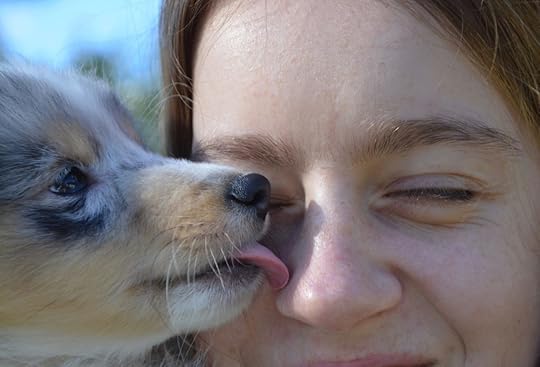 Whether at home, in the hospital, at school, or in a library or other setting, pets offer people joy, comfort, confidence, and companionship.
Whether at home, in the hospital, at school, or in a library or other setting, pets offer people joy, comfort, confidence, and companionship.Therapy Pets at Home
Research shows pets provide great health benefits to people. They can reduce stress, lower blood pressure, uplift our moods, and add years to people’s lives. The simple fact that our pets accept us for who we are, love us unconditionally and are devoted companions makes us smile and builds our confidence and self-esteem. When my shih tzu, Jeremiah, dances excitedly in front of me when I open the door, returning home from work, lifts my spirits. Or, when my husband opens the front door and Jeremiah greets me as I get out of the car, the happiness I feel when I see him and his wagging tail is beyond compare.
Emotional health is important, especially in this year of COVID and political hostility. Our pets offer us the love and acceptance that seems to be waning in human beings, giving us their devotion, putting smiles on our faces, and helping us cope with the challenges that life presents.
Additionally, dogs get us outdoors for fresh air and walks, stimulating better physical health in our lives. Even a simple walk around the block creates better health, both physically and emotionally, for people … and for pets.
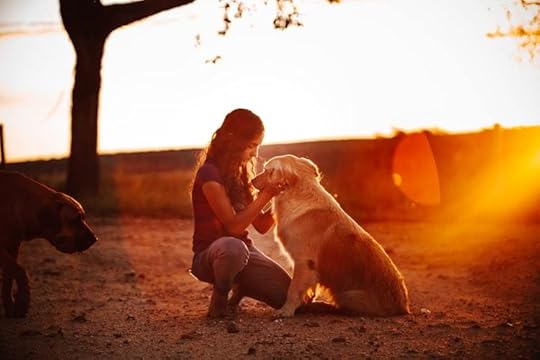 Animals are good for physical health as well as emotional health. Dogs especially get us outdoors and help us socialize … even safely at a distance.
Animals are good for physical health as well as emotional health. Dogs especially get us outdoors and help us socialize … even safely at a distance.Therapy animals, both in our homes and at other places, offer the comfort and joy every person needs in life. No matter what we’re experiencing, we find love, devotion, acceptance, and comfort from the furry friends around us … and we can share that with others by partnering with our pets to help those in our community and our country. Consider certifying yourself and your pet as therapy partners through Pet Partners, The Alliance of Therapy Dogs, Therapy Dogs, International, Intermountain Therapy Animals, or a similar organization.
So hug your pet today in thanks for all the ways s/he provides therapy for you!
October 6, 2020
Creating Community for Community Cats
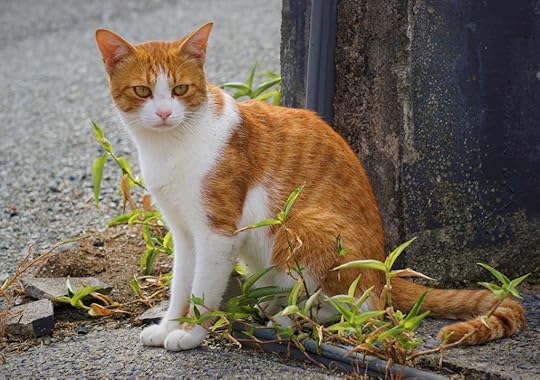 Cats are often abandoned by owners who move, or those who don’t look for their kitties who have escaped the home. Many towns across the U.S. have community cat issues, but there are ways to help these felines in positive ways.
Cats are often abandoned by owners who move, or those who don’t look for their kitties who have escaped the home. Many towns across the U.S. have community cat issues, but there are ways to help these felines in positive ways.A few weeks ago, in my community of Casper, Wyoming, our city council members debated a ban on feeding feral/community cats, among other animal issues. Residents rallied to defend caring for cats that are abandoned, and though most of us know animals neglected and let loose are not the fault of the creatures themselves, sadly, they suffer the consequences, including in political arenas.
Animal lovers prevailed. Our town council listened to the education provided on programs such as Trap, Neuter, Release (TNR) and how community cats can be effectively cared for and how, in many situations, such as abandoned buildings, such cats keep mice and rats at bay. By feeding such cats, supplementing their vermin diet, they are less likely to prey on wild birds, and through TNR, will not reproduce.
Casper is not the only place with community/feral cat issues. However, by working together with local and national organizations, towns across America can implement positive policies. Organizations such as Best Friends Animal Society in Utah and Alley Cat Allies in Maryland assist towns with community cat programs. Even small towns, such as John Day, Oregon, population 1,600, has implemented a TNR and other community cat programs thanks to an all-volunteer organization called Hope4Paws Grant County, helping felines left behind by owners who move and release their cats into the community.
Read this amazing and informative article from Best Friends on how to help cats in your community and how they, as a national leader in animal welfare, helps with this issue: https://bestfriends.org/blogs/2020/08/14/why-our-good-intentions-might-be-killing-more-1000-cats-and-kittens-every-day
If your community is discussing how to handle feral/community cats, use organizations such as Alley Cat Allies and Best Friends as resources.
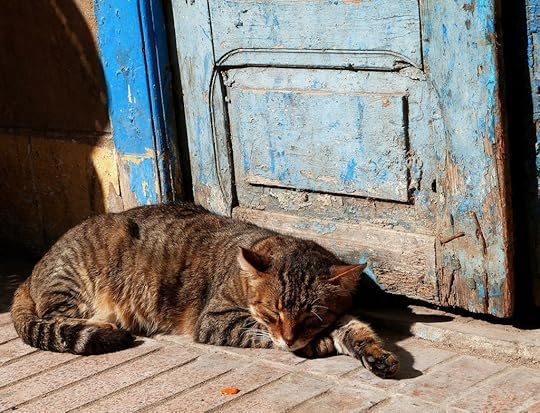 Special programs exist to help communities manage community cats in humane ways. Contact organizations such as the American Society for the Prevention of Cruelty to Animals, Alley Cat Allies, and Best Friends Animal Society for resources and assistance.
Special programs exist to help communities manage community cats in humane ways. Contact organizations such as the American Society for the Prevention of Cruelty to Animals, Alley Cat Allies, and Best Friends Animal Society for resources and assistance.
September 29, 2020
Save a Life: Adopt a Puppy Mill Survivor!
 Previously named Stormy, my adopted puppy mill survivor (now christened Jeremiah) spent the first three years of his life in a puppy mill in the midwestern part of the United States. He was rescued and cared for by Hearts United for Animals, located in southeastern Nebraska.
Previously named Stormy, my adopted puppy mill survivor (now christened Jeremiah) spent the first three years of his life in a puppy mill in the midwestern part of the United States. He was rescued and cared for by Hearts United for Animals, located in southeastern Nebraska. Three years ago this month, a little Shih Tzu named Stormy found his way into my heart and home. This puppy mill survivor turns nine years old today, and if it wasn’t for a wonderful rescue organization called Hearts United for Animals, he might not have lived until his 9th birthday.
One of the missions of the organization is to shut down Midwestern puppy mills. HUA rescued Stormy (whom we renamed ‘Jeremiah’) and several other small dogs from such a facility. Other animal welfare organizations have made puppy mill dogs their focus when it comes to rescue and adoption, including National Mill Dog Rescue, based in Colorado.
Pups with a Troubled Past
We hoped Jeremiah would fit well into our family, but we knew that he might have some issues. Our puppy mill survivor had lived his first three years in appalling conditions that are unfortunately all too typical of puppy mill dogs, including confinement to tiny wire cages stacked atop each other, allowing waste to drop onto the dogs below. On the relatively rare occasions that the cages are cleaned, the dogs suffer as they are trapped as the cages are power-washed. No attention is given to socialization and little to no veterinary care is provided. Jeremiah was not neutered when he came into rescue; he served as one of the mill’s stud dogs when old enough. In this regard he was slightly more fortunate than the females, who are kept pregnant and then are killed when no longer productive.
Mill operators often sell puppies online (such as via Craigslist), through newspaper ads, and to pet stores. In fact, most animal welfare organizations, including Best Friends Animal Society, American Society for the Prevention of Cruelty to Animals (ASPCA), and the Humane Society of the United States warn against purchasing puppies and kittens from pet stores; most of the animals these businesses obtain come from unscrupulous mills (yes, even cats can suffer from such operators).
The challenges of adopting a dog with such a background can be overwhelming to the adopter. Rescues and shelters working with puppy mill survivors note that the dogs are not housetrained, many of them are timid and have significant health issues, and some may have an inability to form attachments to humans.
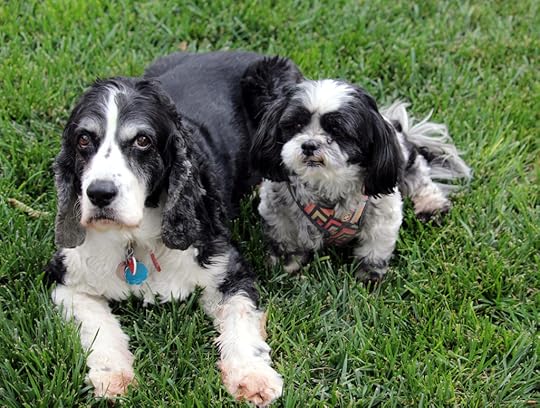 Jeremiah (left) relied on our other dog, Mary, to learn how to become a loving, fun household pet. They were best friends for more than two years. Mary died from canine cancer, a major killer of dogs, in April 2019.
Jeremiah (left) relied on our other dog, Mary, to learn how to become a loving, fun household pet. They were best friends for more than two years. Mary died from canine cancer, a major killer of dogs, in April 2019.Uncertainty
After learning more about Jeremiah’s history, there was a moment of uncertainty. Yet, when I cradled him in my arms at the rescue, I knew in my heart, and pledged in my mind, we would overcome his issues (lack of confidence, not housebroken, and fear of new things). At the time, we had a springer/cocker mix named Mary – a sweet, quiet, gentle dog. From the first car ride together after Jeremiah’s adoption to the day she passed from cancer in 2019, the two dogs were inseparable.
Jeremiah took his cues from her. She helped him learn to potty outside and how to let my husband or I know he needed to go into the backyard. She helped him adjust to living in a house and enjoy sleeping on a dog bed (and the human bed!). She helped him understand people weren’t always cruel, that pats on the head and strokes on the belly were enjoyable, and that a dog could trust people and that people could and would love you and care for you.
Today
Today Jeremiah turns nine; he has spent three years in our home. He grieved for Mary for several months after she passed, but several months later, he became his own dog. Today, Jeremiah is playful. He’s a lap sitter. He loves rides in the car and walks on the leash. He enjoys exploring the woods around our cabin or the areas we visit on daytrips or longer vacations. His independence has sprung forth.
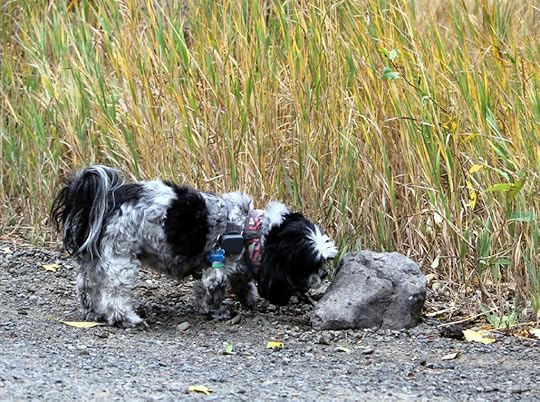 Jeremiah has gained independence since Mary’s passing. He loves to explore the outdoors, take walks, sit on laps, and make new dog friends, especially small dogs.
Jeremiah has gained independence since Mary’s passing. He loves to explore the outdoors, take walks, sit on laps, and make new dog friends, especially small dogs.Jeremiah delights my husband and me. A protruding canine tooth creates a unique smile, and when he runs through the yard, his wispy-black ears fling backward and, like wings, help him soar through the space. His dancing antics at dinner time bring smiles to our faces, and his snuggles while lying beside us on or us stir our souls.
There are challenges when adopting a puppy mill survivor. They don’t always come out of their shell and they may not become fully house-trained, but they deserve love and care just like any other dog … or cat. Pets bring joy to people, and they depend on us for care, compassion, and companionship. I’m grateful to the people at HUA, Mill Dog Rescue, and other rescues and shelters who care enough for animals to rescue and release them from the bondage of mill operators. As I look at Jeremiah, I’m reminded of how far he has come – from confinement to freedom – and I’m so happy I get to celebrate this 9th birthday with him!
Resource
National Mill Dog Rescue has created a helpful guide for people considering adopting or fostering mill animals. View and download that resource here: https://nmdr.org/wp-content/uploads/2013/11/NMDR-From-Puppy-Mill-to-Pet.pdf
 Backyard breeders, also known as ‘millers,’ have dogs simply to produce puppies, keeping the animals in cages and constantly breeding them. Sadly, numerous puppy mills (and kitten mills) exist across the United States. These animals receive little to no socialization with people, bad nutrition, and oftentimes no medical care. Many animal welfare organizations align to help shut down these AHdeplorable operations.
Backyard breeders, also known as ‘millers,’ have dogs simply to produce puppies, keeping the animals in cages and constantly breeding them. Sadly, numerous puppy mills (and kitten mills) exist across the United States. These animals receive little to no socialization with people, bad nutrition, and oftentimes no medical care. Many animal welfare organizations align to help shut down these AHdeplorable operations.HAPPY BIRTHDAY, JEREMIAH!

September 15, 2020
Responsibility, Awareness, and Adoption – All About Education
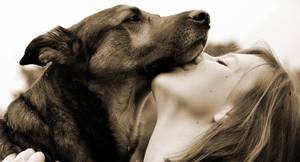
September is a busy month on the “Pet Celebration Calendar.” According to DogTripper.com, this is the time to honor and observe National Service Dog Month, Happy Cat Month, and Pet Sitter Education Month, among many other “pet holidays.”
September is also known as Responsible Dog Ownership Month, which is recognized by the American Kennel Club (AKC). Whether your pooch is a purebred, a mixed breed, or a “designer dog,” you are called to be a responsible owner (and I’ll add: no matter what type of pet you have – cat, ferret, rabbit, parrot, snake, turtle, or the many other types of animals, you are called to be a responsible person for that pet).
What is responsibility? Caring for whatever you do. Whether that’s work, having a human family, or taking in an animal, you are called to take care that aspect of your life. Regarding pets, that includes food, water, socialization, training, and, above all, commitment. The AKC recently provided a list of pet ownership responsibilities; view that here: https://www.akc.org/expert-advice/lifestyle/responsible-dog-owner/
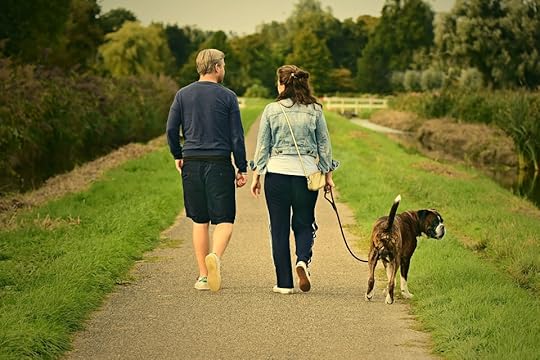 Spending time with you pet, walking, on the couch, or training, helps you and your animal bond more closely and shows pet ownership responsibility.
Spending time with you pet, walking, on the couch, or training, helps you and your animal bond more closely and shows pet ownership responsibility.On Thursday, September 17, the AKC will host a virtual Dog Ownership Responsibility Day with speakers discussing nutrition, therapy dogs, and other topics. Learn more here: https://www.akc.org/sports/responsible-dog-ownership-days/flagship-akc-responsible-dog-ownership-day/
Responsible dog ownership is NOT a part of puppy mills. Saturday, September 19 is considered Puppy Mill Awareness Day. Throughout this nation, unscrupulous dog (and cat) breeders put animals in cages to simply breed them for money. Often these creatures receive little positive human interactions and lack veterinary care. They are fed poor food, live outdoors in squalor, and bred over and over again. Many rescue organizations, such as National Mill Dog Rescue in Colorado and Hearts United for Animals in Nebraska have a specific mission to rescue dogs from such places. My own Jeremiah is one of those rescued by Hearts United for Animals. My husband and I adopted this little, sweet Shih Tzu three years ago this month, and though he had challenges to adjust to living in a home with caring people, he has blossomed into an amazing canine companion, including a lap-sitter!
 My adopted Shih Tzu, Jeremiah, is a puppy mill survivor, thanks to rescue by Hearts United for Animals.
My adopted Shih Tzu, Jeremiah, is a puppy mill survivor, thanks to rescue by Hearts United for Animals.How are such dog and cat breeders allowed to stay in business? Three main reasons: 1. The U.S. Department of Agriculture shuts down very few; 2. Pet stores buy these puppy mill pups and people buy from pet stores; and 3. Breeders use listings such as Craig’s List to sell the animals, and people buy them. Education, through observances like Puppy Mill Awareness Day, can help stop the torture, abuse, and neglect put forth by animal millers. Learn more From the American Society for the Prevention of Cruelty to Animals (ASPCA) here: https://www.aspca.org/barred-from-love
Another special observance takes place this week. Created by the online pet adoption site, Petfinder, Adopt-a-Less-Adoptable-Pet Week helps bring to light the need to adopt animals such as black dogs and cats (which are often the most overlooked in animal shelters), Feline Leukemia positive cats, three-legged, blind, deaf, and senior animals, and large dogs can be seen as “less adoptable” and “less wanted” for various reasons. Yet, these animals also have a lot of love to give. Many with “handicaps” don’t let their disability slow them down … or keep them from learning. For example, you can teach a deaf dog commands by using hand signals.
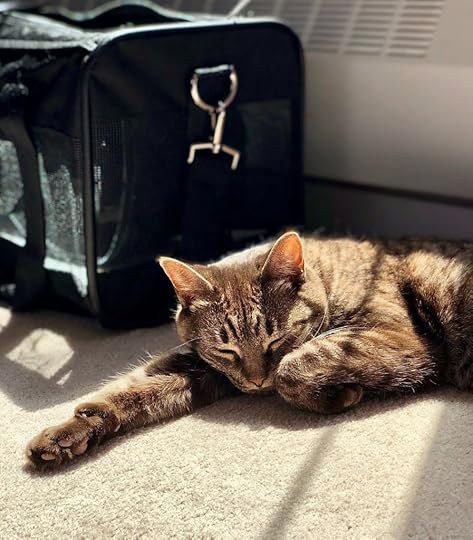 Cats with three legs, those that are older, and those that are positive for feline leukemia are often adopted less often than younger kitties and those people view as “less of a problem.”
Cats with three legs, those that are older, and those that are positive for feline leukemia are often adopted less often than younger kitties and those people view as “less of a problem.”How can you participate in Adopt-a-Less-Adoptable-Pet Week? If you’re not in a situation to adopt, help spread the word about the joy, love, and companionship these animals provide. Help your local shelter promote the adoption of these types of pets currently living at the animal shelter.
All three of these special celebrations – Responsible Ownership, Puppy Mill Awareness, and Adopt-a-Less-Adoptable-Pet Week – revolve around education. Let’s educate ourselves, our family and friends, and the public about these topics and make the world a better place for pets … including our own!



